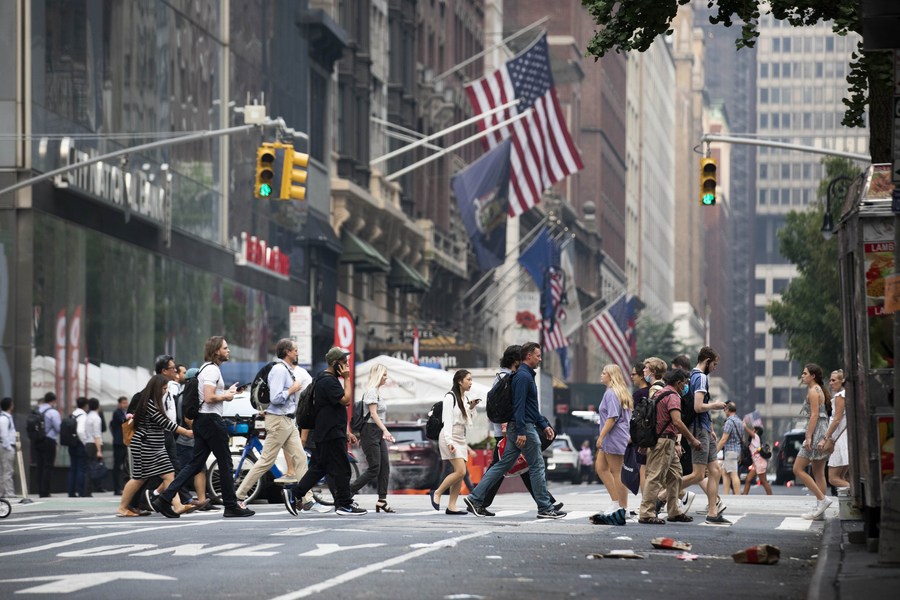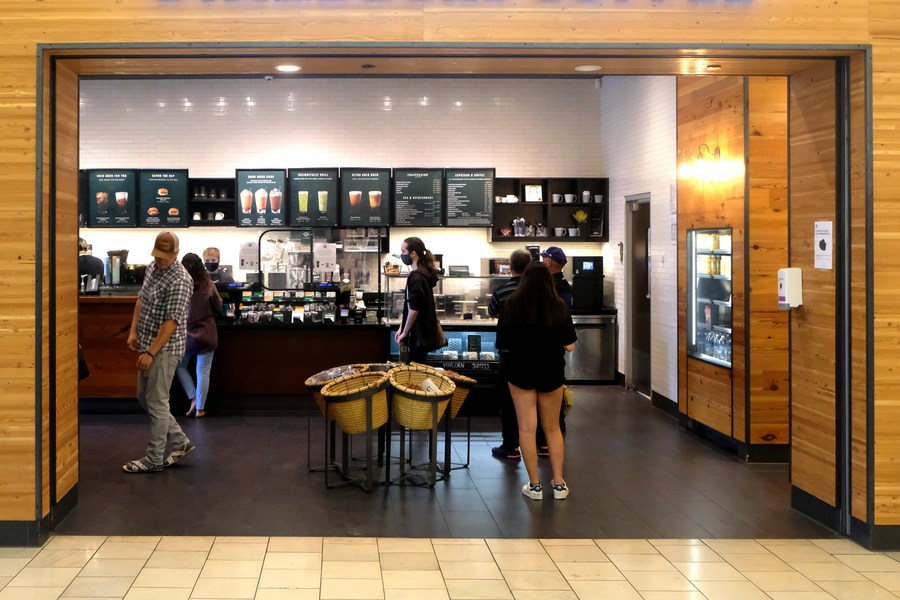Research firms cut U.S. growth forecast after disappointing Q2 GDP print

People walk across a street in Washington, D.C., the United States, July 13, 2021. (Xinhua/Liu Jie)
U.S. real GDP is now set to grow slightly below 7 percent for the year 2021 as a whole, versus earlier expectation of a 7.5-percent expansion, says Prajakta Bhide.
NEW YORK, Aug. 1 (Xinhua) -- Multiple research institutions have reduced their forecasts on U.S. gross domestic product (GDP) growth rate in 2021 following lower-than-expected GDP growth data in the second quarter issued on Thursday.
The U.S. economy in Q2 only grew at 6.5 percent quarter on quarter in terms of seasonally adjusted annual rate (SAAR), well below market expectation of around 8.5 percent, according to data issued by the U.S. Commerce Department.
"This trimmed our 2021 annual growth forecast to 6.2 percent from 6.5 percent," said Michelle Meyer, U.S. economist with BofA Securities, Inc. on Friday.

People walk on a street in New York, the United States, July 20, 2021. (Xinhua/Wang Ying)
Goldman Sachs also reduced its forecast on U.S. GDP growth in the second half of 2021 by one percentage point citing sluggish consumer spending and impacts of the Delta variant.
While keeping its forecast of U.S. economic growth for 2021 unchanged at 6.6 percent, Goldman Sachs said U.S. economic expansion rate would fall to 1.5-2 percent in the second half of 2022.
U.S. real GDP is now set to grow slightly below 7 percent for the year 2021 as a whole, versus earlier expectation of a 7.5-percent expansion, said Prajakta Bhide, U.S. economy and policy strategist with MRB Partners, a New York-based private research firm.

A visitor is seen in a 2021 Lexus LS 500 convertible at the 2021 Chicago Auto Show held at McCormick Place in Chicago, the United States, on July 15, 2021. (Photo by Joel Lerner/Xinhua)
Supply constraints forced business to reach deeper into already-low inventories to meet demand in H1, which are clearly posing a roadblock to even stronger growth with contraction of residential investment in Q2, said Bhide on Thursday.
Component shortages may restrain the business prospects of some companies in the second half, said Salvatore Ruscitti, U.S. equities strategist with MRB Partners.
However, some economists remain positive on the outlook of the overall U.S. economic growth picture, despite this disappointing GDP print in Q2.
"We are not concerned about U.S. growth heading into and through 2022," said Bhide, adding that the overdue positive growth payback from inventory re-building will materialize in 2022 instead of this year.

Customers are seen at a cafe in a shopping mall in San Mateo, California, the United States, July 21, 2021. (Xinhua/Wu Xiaoling)
BofA Securities maintains its forecast on U.S. economic growth in H2 but adjusts the composition, taking up inventories but down residential investment and consumption amid virus headwinds.
The silver lining is that the drop in inventories sets the stage for significant positive payback in coming quarters, which will underpin elevated GDP growth, according to Meyer.
The expansion momentum in the U.S. economy can be sustained due to low inventories at businesses and pent-up consumer demand, according to a research note by UBS Global Wealth Management on Friday.
Photos
Related Stories
- U.S. reports highest daily COVID-19 cases since February
- Experts sure any moves by US Fed won't affect nation's policy much
- Commentary: U.S. attempt to manipulate WHO is ugly
- U.S. Fed inches closer to tapering asset purchases amid inflation, Delta variant concerns
- U.S. failed in COVID-19 response by almost every metric
Copyright © 2021 People's Daily Online. All Rights Reserved.










